15 Powerful Group Art Therapy Ideas: Transform Your Practice with Evidence-Based Activities
January 30, 2025
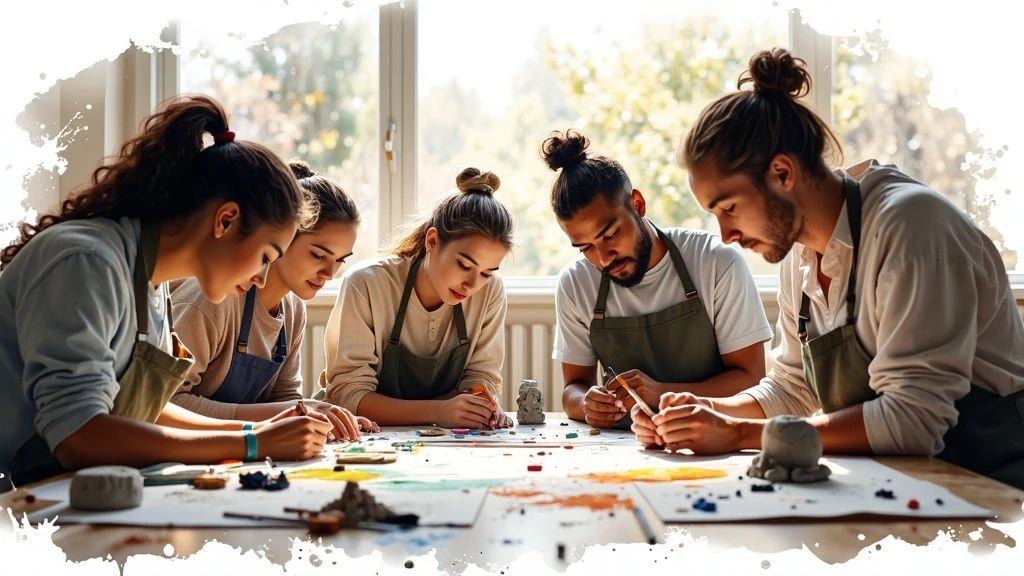
Understanding the Impact of Group Art Therapy
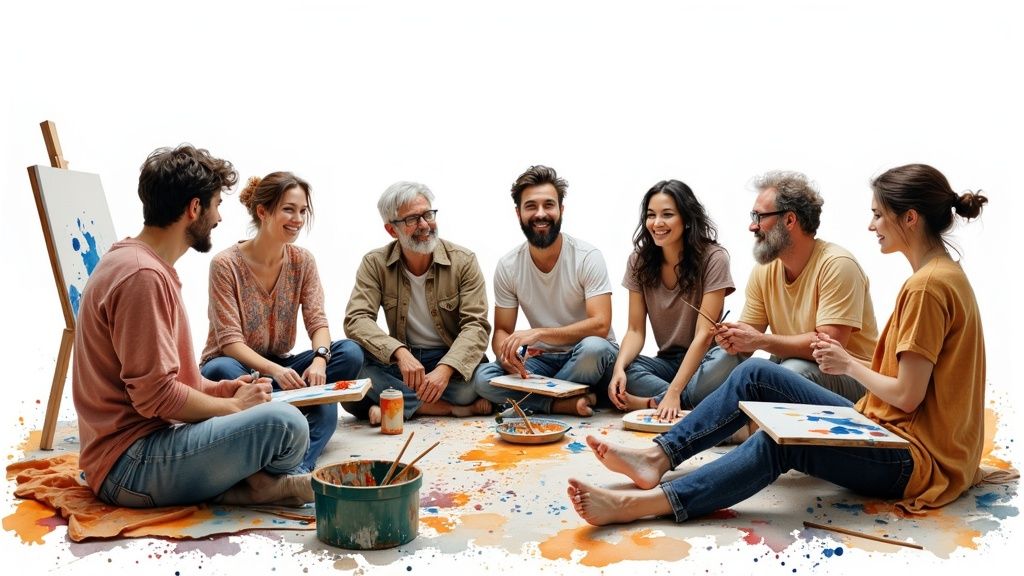
Group art therapy creates powerful connections between people from all walks of life as they explore emotions through creativity. When participants come together to make art, they find a safe space to express themselves and understand each other's experiences. The magic happens when traditional therapeutic approaches blend with hands-on art making - especially through shared projects that build real bonds between people.
Take the Art Therapy Project as a shining example. They've helped over 10,000 people find healing through art, running more than 30 weekly group sessions. When COVID-19 hit, they didn't miss a beat - they started mailing art supplies directly to participants and offering both in-person and online sessions. This flexibility kept the therapeutic connections strong even during isolation. Learn more about their impact.
Key Elements That Make It Work
The best group art therapy programs combine proven methods with fresh approaches to meet each group's specific needs. Here's what makes these programs tick:
- Welcome Everyone: Activities that work for different cultures and abilities
- Share Your Story: Projects like "Tree of Life" that help people tell their journey through art
- Build Connection: Creative projects that bring people together to heal
Finding the sweet spot between tested techniques and new ideas helps these programs stay effective while meeting today's therapeutic needs. The goal goes beyond just expressing emotions - it's about building stronger social connections and inner strength.
How We Know It's Working
Good programs keep track of their results in practical ways:
- Before and After Check-ins: Looking at how people's emotional state changes
- Group Discussion: Learning from everyone's insights to make things better
- Personal Journals: Tracking individual growth over time
Real therapists constantly fine-tune their methods based on what works best for their groups. This careful attention helps create spaces where real healing can happen.
Want to try some art therapy techniques at home? Check out: How to master adult coloring techniques for stress relief. By mixing traditional art with mental health practices, art therapists are making these powerful tools available to more people than ever.
Clay-Based Activities for Deep Emotional Connection
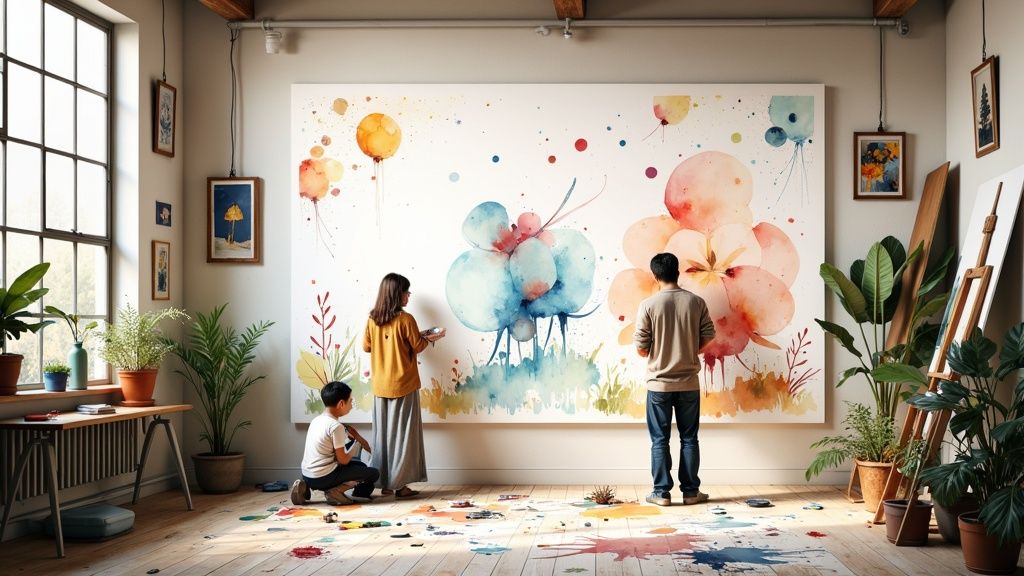
Working with clay in group art therapy creates powerful opportunities for emotional expression and connection. The simple act of handling clay engages multiple senses - touch, sight, and even smell - which helps people tap into deeper feelings. For many participants, physically molding the clay provides a natural way to express emotions they find hard to put into words. The hands-on nature of clay work also tends to have a grounding, calming effect.
Exploring Emotions Through Clay Sculptures
Creating personal sculptures gives group members a concrete way to explore and share their emotional experiences. Each person chooses an emotion to work with, then shapes the clay to match how that feeling manifests for them. Someone processing anger might create spiky, irregular forms, while another person working with sadness may craft flowing, heavy pieces. When participants share their sculptures with the group, it often sparks meaningful conversations and builds understanding between members.
Building Group Cohesion With Collaborative Clay Projects
Group clay projects help build trust and connection between participants in a natural way. As members work together on a shared piece, they practice communication and compromise while staying focused on a common creative goal. The finished sculpture becomes a physical symbol of what the group can accomplish together. Research has shown that clay-based group art therapy significantly reduces feelings of isolation in older adults, with measurable drops in loneliness and hopelessness. You can read more about these findings here.
Adapting Clay Activities for Diverse Needs
One of clay's strengths is how easily it can be adapted for different abilities and comfort levels. Basic techniques like pinching and rolling work well for those with limited mobility, while more complex methods provide extra challenge when appropriate. Having various tools and approaches available lets each person engage with the clay in a way that feels right for them.
Practical Tips for Facilitating Clay-Based Group Art Therapy
To run effective clay therapy sessions, keep these key points in mind:
- Preparation: Have enough workspace, tools, and materials ready before starting
- Guidance: Show and explain techniques clearly through demonstrations
- Processing: Lead thoughtful discussions about the meaning behind created pieces
- Clean-up: Set clear routines for cleaning materials and space
With good planning and facilitation, clay work gives groups a rich opportunity to explore emotions, build relationships, and support each other's growth in a hands-on, engaging way.
Implementing Structured Sessions in Academic Settings
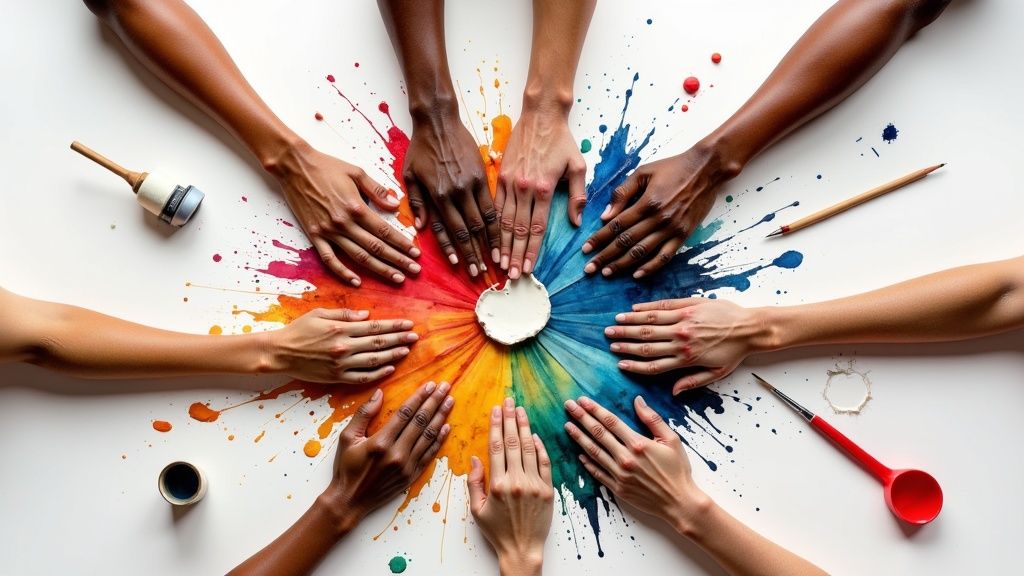
Setting up effective group art therapy in schools takes careful planning and a solid understanding of classroom dynamics. The key is creating an environment where every student feels welcome and supported, regardless of their background or artistic ability. This is especially important in diverse classrooms where students come from different cultural backgrounds and have varying comfort levels with creative expression.
Making Sessions Work for Everyone
The best art therapy sessions keep students engaged by offering activities that work for different skill levels and learning styles. A proven approach is breaking sessions into three main parts - opening activities, core exercises, and reflection time. This structure helps students process their emotions and reduce stress gradually. For instance, a recent study of 30 graduate students in China found that eight two-hour art therapy sessions made a real difference in lowering stress levels. Want to learn more? Check out the complete research findings.
Working With Different Age Groups
Young kids and teenagers need different approaches to art therapy. Elementary students do well with simple projects exploring basic emotions and self-expression through drawing or painting. High school students can handle deeper discussions about personal growth, relationships, and social issues that matter to them. Need fresh ideas for teaching through visuals? Take a look at these practical visual learning strategies.
Making Programs Last
For art therapy to become a permanent part of school programs, you need to show it makes a real difference. Here's what works:
- Track Results: Use simple before-and-after assessments to measure emotional and social growth
- Keep Records: Save student artwork and written reflections to show individual progress
- Get Support: Share student success stories with teachers, parents and school leaders
When you plan carefully and track results, art therapy can become a valuable tool for supporting students' emotional wellbeing and creative development at school.
Mastering Clinical Applications in Psychiatric Settings
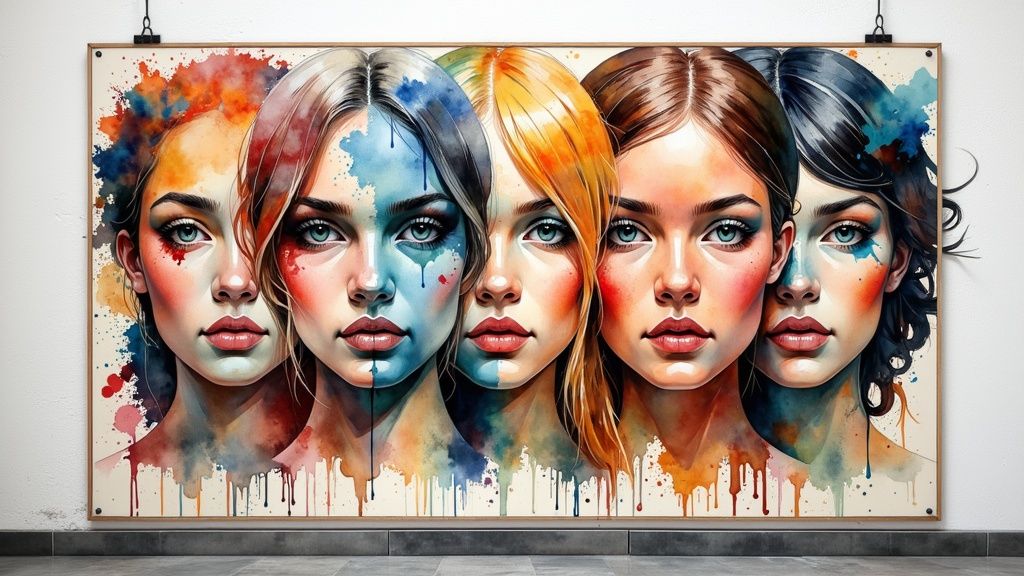
Art therapy groups provide a powerful outlet for expression in psychiatric settings, where many patients find it challenging to put their feelings into words. The setup of these groups can take different forms - from free-flowing open studios to more directed sessions with specific activities. How a therapist structures the group significantly impacts both individual participation and group dynamics.
Consider a structured session format, which works well for patients who need clear boundaries and predictable routines to manage their symptoms. These sessions often focus on specific themes or techniques that help ground participants during difficult emotional states. On the flip hand, open studio sessions give patients more freedom to explore their creativity and rebuild their sense of autonomy.
This careful attention to group structure emerged from major changes in psychiatric care during the 1960s and 1970s. As hospitals moved away from long-term care toward shorter stays, art therapists adapted their methods to serve patients more effectively in limited time frames. Studies from this period, particularly Young's research, showed how different group formats could support various therapeutic goals. Learn more about the evolution of psychiatric art therapy.
Balancing Structure and Creative Freedom
The format is just one aspect of running effective art therapy groups. Therapists must also manage group dynamics while tracking each patient's progress. They use several methods to measure outcomes, including:
- Regular feedback from participants
- Art exhibitions showcasing patients' work
- Observations of behavior changes during sessions
These programs work best when they blend creative expression with clinical care in a way that fits each person's treatment plan. By paying attention to individual needs and backgrounds, art therapists create spaces where patients can heal through artistic exploration. The flexibility of group art therapy makes it particularly valuable in psychiatric settings.
Creating Engaging Digital and Hybrid Therapy Experiences
Physical separation no longer limits the therapeutic power of art therapy. Mental health professionals have successfully adapted their practices to include both virtual and in-person elements, creating new ways to connect with and support their clients. This blend of approaches helps people engage in healing creative work from wherever they feel most comfortable.
Overcoming Technical Challenges with Practical Solutions
Setting up effective online therapy sessions starts with having the right tools and backup plans. Popular video platforms like Zoom and Microsoft Teams work well for face-to-face interaction, while digital art apps like Procreate give clients creative freedom. Even basic tools like Microsoft Paint can spark artistic expression.
Here's what therapists need to prepare:
- Test Equipment Thoroughly: Check internet connection, camera, and audio before sessions
- Create Clear Guidelines: Give step-by-step tech setup instructions to participants
- Have Backup Activities: Keep simple alternatives ready if tech issues arise
Enhancing Digital Engagement with Innovative Tools
The right digital tools can make online art therapy feel just as hands-on as in-person sessions. Jamboard and Mural enable real-time group projects where everyone can contribute artwork together. Some therapists even use virtual reality to create immersive spaces where clients can freely express themselves.
For instance, a group session might feature a shared digital canvas where each person adds their own drawings or designs. This mirrors the collaborative energy of painting together in a studio while allowing everyone to participate from their own space.
Managing Group Dynamics in Virtual Spaces
Building community in online groups takes special attention to how people interact and connect. Clear guidelines and regular check-ins help everyone feel included and heard. Therapists set the tone by showing openness to feedback and flexibility with different communication styles.
Ensuring Accessibility for All Participants
Making digital art therapy work for everyone means thinking through different needs and abilities. Adding features like closed captions, language support, and flexible scheduling helps more people take part. Not everyone has fancy drawing tablets or VR gear, so sessions should work with basic tools too. A recent study found that 90% of people participated more fully when sessions included these accessibility features.
For more creative ideas you can use at home, check out our guide to mastering advanced coloring pages for adults which explores art as a mindfulness practice.
While moving therapy online brings some challenges, thoughtful planning and the right tools create meaningful spaces for healing and creative growth. The key is focusing on connection and expression, regardless of the format.
Evaluating Impact and Refining Your Approach
Tracking the success of your art therapy programs requires more than just observation. By collecting data systematically and incorporating participant feedback, you can measure real impact and make targeted improvements.
Gathering Feedback and Measuring Progress
Set up regular opportunities for participants to share their experiences through individual interviews, group discussions, or written surveys. These direct conversations often surface insights you might otherwise miss about what's working and what needs adjustment.
To get clear data on emotional and psychological changes, use proven assessment tools like the UCLA Loneliness Scale or Beck Hopelessness Scale. Tracking these metrics over time, along with participants' personal reflections, gives you a complete picture of their growth.
Some programs have seen impressive results from this combined approach. One study found that incorporating regular participant feedback led to a 15% boost in emotional well-being scores among group art therapy participants.
Tracking Long-Term Impact
Understanding lasting benefits means following up with participants even after they complete therapy. Create a simple system to check in periodically and document their ongoing progress. Good record-keeping helps identify which aspects of your program create lasting positive change.
Balancing Clinical Needs with Practical Constraints
Make your evaluation process work in the real world by:
- Keeping it simple: Choose easy-to-use assessment tools that don't overwhelm participants or staff
- Protecting privacy: Store all personal information securely and follow ethical guidelines
- Finding the right timing: Set evaluation schedules that match your program's pace and goals
Real-World Examples of Successful Frameworks
Look at how other organizations handle program assessment. The Art Therapy Project shows how to balance clinical requirements with practical limitations, using data to guide program improvements. Their flexible approach helped them adapt quickly when COVID-19 changed how they needed to work.
Strengthening Your Programs with Results
Good data helps you improve participant experiences and make a strong case for program support. Share both numbers and stories with stakeholders to show concrete progress. When you can demonstrate clear benefits, you build trust and create opportunities for growth.
Call to Action
Want to add engaging new tools to your therapy practice? See how ColorPageAI can provide custom coloring pages that enhance your expressive therapy work. Check it out today!
Ready to start coloring?
Join ColorPage.ai today and get 5 free credits to create your own custom coloring pages!
Start creating